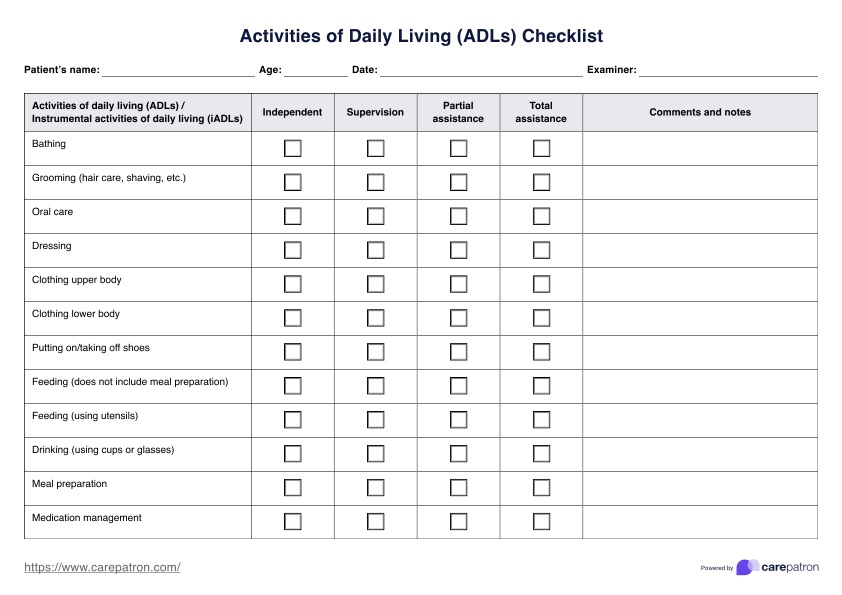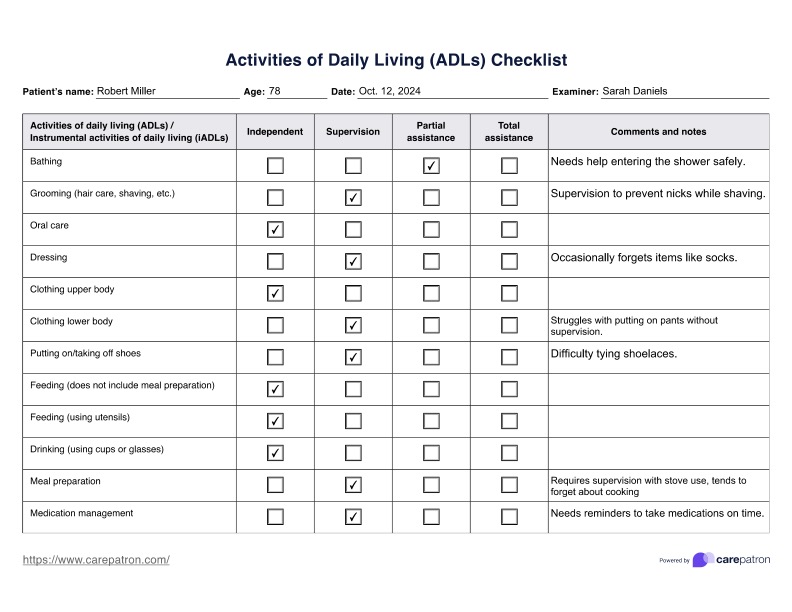Activities Of Daily Living
Download our Activities of Daily Living Checklist to optimize daily care. Streamline assessments, track progress, and tailor care plans.

By Joshua Napilay on Jul 21, 2024.


Table of content
What is an Activities Of Daily Living Checklist?
Activities of daily living (ADLs) are essential tasks that individuals perform daily to maintain their independence and well-being. For healthcare practitioners, understanding and assessing ADLs is crucial in providing comprehensive care, especially for older adults and those with cognitive impairments. This guide explores the concept of ADLs, assessment tools, and their importance in healthcare settings.
Activities of daily living encompass a range of basic and instrumental tasks necessary for independent living. These activities are broadly categorized into two groups:
1. Basic activities of daily living (BADLs)
Basic ADLs include fundamental self-care tasks such as:
- Personal hygiene (bathing, grooming, nail care)
- Dressing
- Eating
- Toileting
- Transferring (moving from bed to chair, etc.)
- Walking or functional mobility
2. Instrumental activities of daily living (IADLs)
IADLs are more complex tasks that support independent living:
- Meal preparation
- Managing medications
- Managing finances and paying bills
- Housekeeping and home maintenance
- Using public transportation
- Shopping
- Using communication devices
PDF Template
Example PDF
Activities Of Daily Living Template

Activities Of Daily Living Example

ADL assessment tools
Several standardized measures and functional assessment tools are available to evaluate an individual's ability to perform ADLs:
- Katz Index of Independence in Activities of Daily Living: The Katz Index is one of the most commonly used tools to assess basic ADLs. It evaluates six functions: bathing, dressing, toileting, transferring, continence, and feeding. The index ranks the adequacy of performance in these functions and provides a simple, standardized measure of biological and psychosocial function.
- Lawton-Brody instrumental activities of daily living scale: This scale assesses eight domains of function related to IADLs: using the telephone, shopping, food preparation, housekeeping, laundry, transportation, medication management, and finances. It is particularly useful for identifying how a person is functioning at present and detecting improvement or deterioration over time.
- Barthel Index: The Barthel Index measures performance in 10 activities of daily living. It is widely used to assess functional status and determine the level of assistance required for individuals with neuromuscular or musculoskeletal disorders.
- Texas functional living scale: This assessment tool evaluates functional abilities in individuals with mild cognitive impairment or early-stage dementia. It assesses four domains: time, money and calculation, communication, and memory.
How does our Activities of Daily Living Checklist work?
This activities of daily living scale PDF can be used in practice by healthcare practitioners through the following steps:
Introduction and explanation
Introduce the ADL assessment tool to the individual, caregiver, or family member. Explain the checklist's purpose, emphasizing its role in assessing daily functioning and identifying areas requiring support or intervention.
Review of ADL categories
Familiarize the individual with the key ADL categories, including personal hygiene, dressing, eating, continence, mobility, and instrumental activities. Ensure understanding of each category's significance in determining overall independence.
Self-assessment or observer input
Encourage the individual to self-assess their abilities in each ADL category. Let them use the rating scale, Ranging from "independent" to requiring "total assistance," to assess the individual's level of functional ability in each ADL. The scale helps quantify the degree of assistance required for each activity.
Documentation of observations
Record specific observations for each ADL, noting any challenges, dependencies, or areas of strength. Documenting these details aids in developing targeted care plans and interventions.
Analysis and summary
Analyze the overall assessment to identify patterns, trends, or areas of concern. Summarize the findings to facilitate communication among healthcare professionals, caregivers, and individuals.
Development of care plan
Based on the assessment, create a personalized care plan that addresses specific needs and promotes independence. Specify interventions, support services, or adaptive strategies to enhance daily functioning.
When would you use this checklist?
The Activities of Daily Living Checklist is a valuable resource employed by various healthcare practitioners to assess an individual's functional capacity and independence in performing essential self-care tasks. The checklist is handy in the following scenarios:
- Geriatric assessment: Geriatricians and healthcare professionals specializing in elder care often use the ADL Checklist to evaluate the functional status of older adults. It aids in identifying age-related declines in daily living activities and guides the development of care plans for maintaining independence.
- Rehabilitation settings: An occupational therapist or other rehabilitation specialists utilize the ADL Checklist to assess the progress of individuals recovering from injuries, surgeries, or debilitating conditions. The checklist helps tailor rehabilitation plans to improve specific areas of functional impairment.
- Home healthcare services: Home healthcare providers use the ADL Checklist to assess the needs of clients receiving home care. The checklist guides the development of personalized care plans, ensuring that caregivers address specific challenges in daily living.
- Assisted living and nursing homes: Staff in assisted living facilities and nursing homes employ the ADL Checklist as part of routine resident assessments. It informs the level of care provided, helps with care planning, and serves as a baseline for monitoring changes in functional abilities.
What do the results mean?
The Activities of Daily Living Checklist results provide valuable insights into an individual's functional abilities and independence in performing essential self-care tasks. Common results can be interpreted as follows:
- Independent: Individuals marked as "independent" across all ADL categories can manage daily living activities without significant assistance. This result suggests a high level of functional independence and self-sufficiency.
- Partial assistance: Some individuals may demonstrate independence in specific ADLs while requiring assistance in others. This result highlights areas where support or intervention may be needed, allowing for targeted care planning.
- Complete assistance: "Complete assistance" across multiple ADL categories signals that the individual relies heavily on others for various aspects of daily living. This result may prompt a comprehensive assessment to determine the extent of support required and the potential impact on overall quality of life.
- Baseline for care planning: The results serve as a baseline for developing personalized care plans. Healthcare practitioners use the information to identify specific needs, set realistic goals, and tailor interventions to enhance daily functioning.






